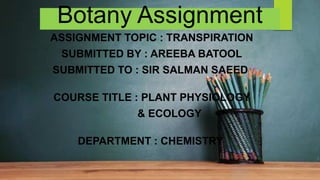
Transpiration in plants
- 1. Botany Assignment ASSIGNMENT TOPIC : TRANSPIRATION SUBMITTED BY : AREEBA BATOOL SUBMITTED TO : SIR SALMAN SAEED COURSE TITLE : PLANT PHYSIOLOGY & ECOLOGY DEPARTMENT : CHEMISTRY
- 2. Transpiration Transpiration is the biological process by which water is lost in the form of water vapour from the aerial parts of the plants.” Transpiration in Plants : V Like all living organism, plants also require an excretory system to discharge excess water from their body. v This process of elimination of excess water from the plant body is known as transpiration. It is generally the evaporation of water from the surface of the leaves. V During the process of transpiration, water molecules in the plant tissues are removed from the aerial parts of the plants. Only a small amount of water absorbed by the plants is utilized in growth and development. The rest is eliminated in the form of transpiration.
- 3. diagram 1
- 4. Discovery details U Transpiration was first measured by Stephen Hales (1677–1761), an English botanist and physiologist. He noticed that plants “imbibe” and “perspire” significant amounts of water compared to animals and created a novel method for measuring the emission of water vapour by plants. He found that transpiration occurred from the leaves and that this process encouraged a continuous upward flow of water and dissolved nutrients from the roots. Modern research has shown that as much as 99 percent of the water taken in by the roots of a plant is released into the air as water vapour. U Excessive transpiration can be extremely injurious to a plant. When water loss exceeds water intake, it can retard the plant’s growth and ultimately lead to death by dehydration.
- 5. TYPES OF TRANSPIRATION 1.Stomatal Transpiration : On the epidermis of leaves, stomata are tiny pores. Stomata can also be observed on the epidermis of green stems in herbaceous plants. They serve as a link between internal tissue and the outer environment. As a result, they are the primary conduit for the escape of water vapour. Stomatal transpiration is responsible for 80-90 percent of the plant’s total water loss. Example : The evaporation of water from a plant’s stomata is known as stomatal transpiration. The stomata are where most of the water transpired from a plant’s leaves departs; at least 90% of the water transpired from a plant’s leaves exits through the stomata.
- 6. Cuticular Transpiration 2. Cuticular Transpiration : •: The epidermis of leaves and stems is protected by a waxy coating of cutin and cuticle. The presence of cuticles on the epidermis’s surface inhibits water evaporation directly. If the cuticle is thin, it may be responsible for up to 20% of total transpiration. However, as the thickness of the material grows, the amount of water vapour loss decreases. Under normal conditions, cuticular transpiration contributes for around 10% of the total amount of transpiration from leaf. • Example : The evaporation of water from a plant’s cuticle is referred to as cuticular transpiration. A waxy film covers the surface of a plant’s leaves, and it’s known as the cuticle. The cuticle loses roughly 5-10% of the water in the leaves, so this method of transpiration does not account for much of a plant water loss.
- 7. Lenticular Transpiration Lenticular transpiration: • • Small gaps in the cork of woody stems, branches, and fruits are known as lenticels. These apertures allow water vapour to escape. Lenticular transpiration is the loss of water through lenticels seen on woody stems and fruits. It accounts for about 1% of a plant’s overall water loss. Lenticular transpiration can be significant in deciduous trees that drop their leaves in the autumn. • Example : Evaporation of water from such a plant’s lenticels is known as lenticular transpiration. The bark of branches and twigs has microscopic openings called lenticels. Lenticels are not found in every plant. When compared to stomatal transpiration, the amount of water lost by this method is relatively modest, although it can grow in a dry environment, just like cuticular transpiration.
- 9. Leaf 🌿 Internal Structure
- 11. Factors Affecting on the Rate of Transpiration in Plants
- 12. Environmental Factors The environmental factors rate of transpiration are affecting the rate : 1.Humidity, 2.Temperature, 3.Atmospheric pressure, 4.Wind speed or velocity. Relative Humidity : The amount of water vapour present in the air at a particular time and temperature is expressed as a percentage of the amount required for saturation at the same temperature. The rate of transpiration is inversely proportional to relative humidity. More the relative humidity less is the transpirate rate. Temperature : A high temperature lowers the relative humidity and opens the stomata even in darkness. As a result, the rate of transpiration increases.
- 13. Factors Light The stomata open during the day and close in the dark. Presence of light is directly proportional to the rate of transpiration. Air If the air is still, the transpiration rate is low. This is because the water vapour accumulates around the transpiring organs and reduce the diffusion pressure deficit of the air. If the air is moving, the saturated air around the leaves is removed and the transpiration rate increases. Water Availability The transpiration rate is directly proportional to the absorption of water by the roots from the soil. A decrease in water absorption causes the closure of stomata and wilting, thereby reducing the rate of transpiration.
- 14. 1. Students
- 15. JazakAllah